SME Finance Policy Guide
SME Finance Policy Guide
SME Finance Policy Guide
Create successful ePaper yourself
Turn your PDF publications into a flip-book with our unique Google optimized e-Paper software.
G-20 <strong>SME</strong> FINANCE POLICY GUIDE<br />
15<br />
Regulators and supervisors play a key role in the<br />
design and implementation of an enabling environment<br />
for <strong>SME</strong> finance, which includes providing the<br />
legal and regulatory framework in support of <strong>SME</strong><br />
access to finance, and can also include interventions<br />
promoting <strong>SME</strong> finance, and the collection and analysis<br />
of data on financial inclusion. While data collection<br />
can support the prudent development of <strong>SME</strong><br />
finance through enabling effective supervision of<br />
expanding provision of financial services, and<br />
through providing much needed market data to<br />
financial institutions, other regulatory measures<br />
have risked distorting markets or have been<br />
counterproductive.<br />
For example, interest rate ceilings designed to make<br />
finance more affordable may actually depress <strong>SME</strong><br />
lending volumes, while directed lending, for example<br />
through requirements for banks to set up branches in<br />
rural areas or to lend to certain <strong>SME</strong> sectors, can add<br />
costs and risks for <strong>SME</strong> lending. Exemptions on<br />
reserve requirements have been used to try and stimulate<br />
<strong>SME</strong> lending, and in some cases to lower the<br />
interest rates for <strong>SME</strong> borrowers. For example, the<br />
Egyptian central bank waived its 14 percent reserve<br />
requirement on loans to <strong>SME</strong>s, for an amount equal<br />
to the <strong>SME</strong> lending of each bank. The Jordanian central<br />
bank also reduced reserve requirements for an<br />
amount equivalent to <strong>SME</strong> lending, on the condition<br />
that banks lent at a lower rate (relative to the prime<br />
rate) to <strong>SME</strong>s.<br />
Standards, guidelines, good practice<br />
The policy and regulatory framework should be proportionate<br />
with the risks involved in such innovative<br />
products and services, and is based on an understanding<br />
of the gaps and barriers in existing regulation.<br />
Under a proportional regulatory framework, regulatory<br />
requirements vary with the benefits and risks<br />
associated with a financial service or the provider of<br />
the financial service. The aim should be for regulatory<br />
policies that enable, rather than inhibit, appropriate<br />
innovation in connection with regulated activities in a<br />
way that manages risk. The challenge lies in tailoring<br />
regulation to mitigate the risks of specific types of services<br />
and delivery approaches without imposing an<br />
undue regulatory burden that could stifle innovation.<br />
Proportionality in regulation can be accomplished, for<br />
example, by setting different requirements correlated<br />
with the differing levels and types of risk involved in<br />
different activities. Regular, thorough diagnostic exercises<br />
that identify the gaps and barriers in current<br />
policy and regulation should inform sound innovative<br />
financial inclusion policy formulation, as the experiences<br />
of Argentina, Russia, and Mexico demonstrate.<br />
Such reviews are important because the barriers and<br />
gaps in existing regulation that prevent innovative<br />
financial inclusion reaching scale rapidly, yet safely,<br />
are not necessarily obvious.<br />
While designing and enforcing an enabling environment<br />
and intervention mechanisms in support of <strong>SME</strong><br />
access to finance, regulators need to keep overarching<br />
objectives in mind: ensuring the stability of the financial<br />
system, promoting financial literacy and consumer<br />
protection, and respecting Anti-Money Laundering<br />
(AML) and Combatting the Financing of Terrorism<br />
(CFT) regulations. The pursuit of these objectives can<br />
involve trade-offs with measures aimed at widening<br />
access to finance. The design of access to finance<br />
reforms needs to be balanced with these overarching<br />
objectives in mind, and the South Africa example on<br />
page 17 illustrates how this can be achieved in an<br />
emerging market.<br />
Regulators can also collect and evaluate data on <strong>SME</strong><br />
access to finance, building on credit registry and<br />
other reporting data that they do or could collect.<br />
Financial inclusion data is critical in supporting evidence-based<br />
policymaking, helping inform the prioritization<br />
of efforts, and tracking progress of the<br />
proposed targets. Without standardized, comparable,<br />
and regularly updated data at the global and national<br />
level, progress tracking and target setting is suboptimal<br />
and lacks direction. Thus, data and measurement<br />
is a key and indispensable area of work that<br />
requires: i) defining measurable financial inclusion



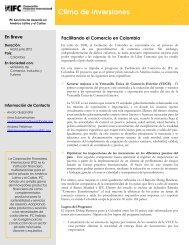
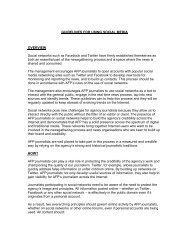
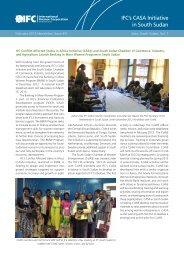

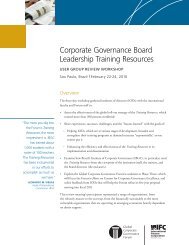




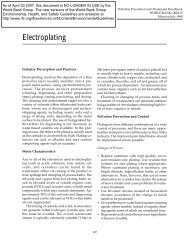

![Print a two-page fact sheet on this project [PDF] - IFC](https://img.yumpu.com/43449799/1/190x245/print-a-two-page-fact-sheet-on-this-project-pdf-ifc.jpg?quality=85)


